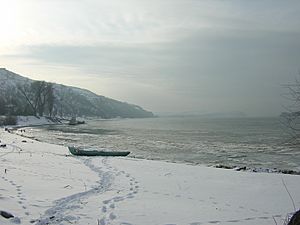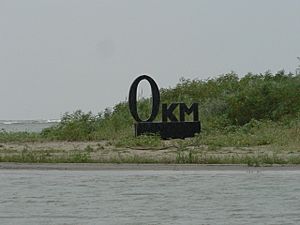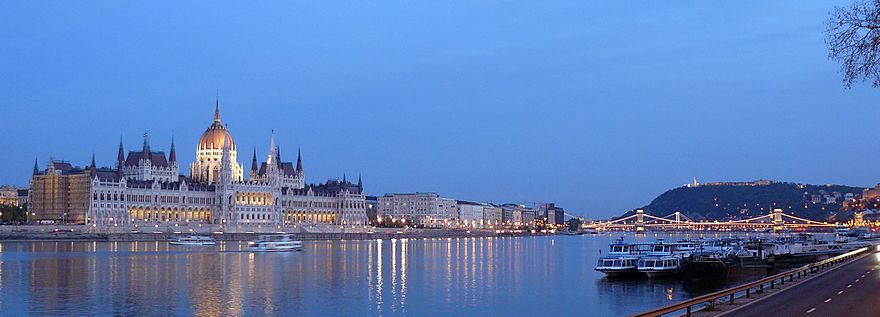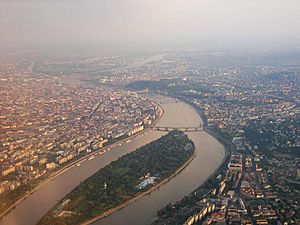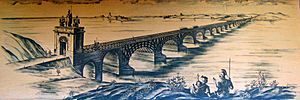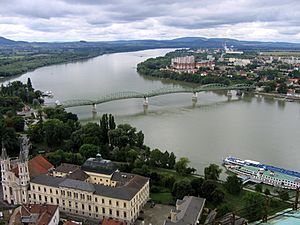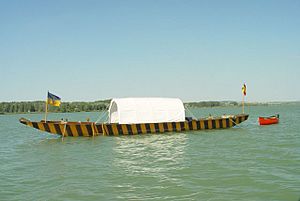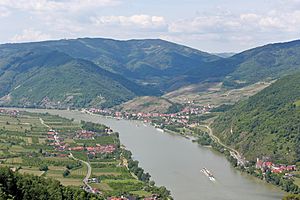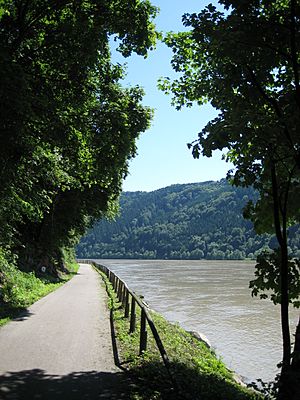Danube facts for kids
The Danube is the second-longest river in Europe, after the Volga. It's also the longest river that flows entirely within the European Union. The Danube is about 2,860 kilometers (1,777 miles) long. It starts when two smaller rivers, the Brigach and Breg, join together in Donaueschingen, a town near the Black Forest in Germany.
The Danube flows through or touches the borders of 10 countries: Germany, Austria, Slovakia, Hungary, Croatia, Serbia, Romania, Bulgaria, Moldova, and Ukraine. It finally empties into the Black Sea through a special area called the Danube Delta.
Many important cities are located along the Danube. These include Ulm and Regensburg in Germany; Linz and Vienna (the capital of Austria) in Austria; Bratislava (the capital of Slovakia) in Slovakia; Budapest (the capital of Hungary) in Hungary; Vukovar in Croatia; and Novi Sad and Belgrade (the capital of Serbia) in Serbia.
The Danube is known by different names in many languages. For example, it's called Donau in German, Duna in Hungarian, and Dunăre in Romanian.
The river is a very important route for boats and ships. Large ocean ships can travel up to Brăila in Romania. Smaller river boats can go even further upstream to Kelheim in Germany, and very small ships can reach Ulm.
There are also three special canals connected to the Danube that help ships travel:
- The Danube-Tisa-Danube Canal (DTD) in Serbia.
- The Danube-Black Sea Canal in Romania, which makes the journey to the Black Sea 400 km (249 miles) shorter.
- The Rhine-Main-Danube Canal, which connects the Danube all the way to the North Sea in Germany. This canal was finished in 1992 and links the North Sea to the Black Sea!
Contents
Where Does the Danube Flow?
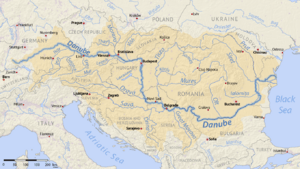
The Danube is considered an international waterway, meaning many countries share it. It begins in Donaueschingen, Germany, where the Brigach and Breg rivers meet. From there, the Danube flows southeast for about 2,800 kilometers (1,740 miles). It passes through four capital cities before reaching the Black Sea through the Danube Delta in Romania and Ukraine.
Long ago, the Danube was a border for the Roman Empire. Today, it flows through or touches the borders of 10 countries. These are Romania, Hungary, Serbia, Austria, Germany, Bulgaria, Slovakia, Croatia, Ukraine, and Moldova. The area of land that drains water into the Danube, called its drainage basin, is even larger and includes parts of nine more countries like Bosnia and Herzegovina, the Czech Republic, and Switzerland. The highest point in this drainage basin is Piz Bernina in the Alps, which is 4,049 meters (13,284 feet) high.
Rivers Joining the Danube

Many other rivers flow into the Danube. These are called its tributaries. Some of these tributaries are big enough for boats to travel on them too. Here are some of the main rivers that join the Danube, listed from its start to its end:
- Iller (at Ulm)
- Lech
- Altmühl (at Kelheim)
- Naab (at Regensburg)
- Regen (at Regensburg)
- Isar
- Inn (at Passau)
- Ilz (at Passau)
- Enns
- Morava (near Devín Castle)
- Rába (at Győr)
- Váh (at Komárno)
- Hron (at Štúrovo)
- Ipeľ
- Sió
- Dráva
- Vuka (at Vukovar)
- Tisza
- Sava (at Belgrade)
- Tamiš (at Pančevo)
- Great Morava
- Caraș
- Jiu (at Bechet)
- Iskar (near Gigen)
- Olt (at Turnu Măgurele)
- Osam (near Nikopol, Bulgaria)
- Argeș (at Oltenița)
- Ialomița
- Siret (near Galați)
- Prut (near Galați)
Cities and Towns Along the Danube
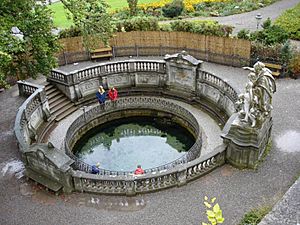

The Danube flows through many cities and towns. It passes through four national capital cities, which is more than any other river in the world! Here are some of them, listed from the river's source to its mouth:
 Germany
Germany
- Donaueschingen (where the Danube begins)
- Ulm
- Regensburg
- Passau
 Austria
Austria
 Slovakia
Slovakia
- Bratislava (capital of Slovakia)
- Komárno
 Hungary
Hungary
 Croatia
Croatia
- Vukovar
 Serbia
Serbia
 Bulgaria
Bulgaria
- Vidin
- Ruse
- Silistra
 Moldova
Moldova
- Giurgiulești
 Ukraine
Ukraine
- Izmail
- Vylkove
 Romania
Romania
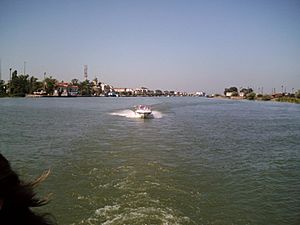 The Danube in Sulina, Romania.
The Danube in Sulina, Romania.
Islands in the Danube
The Danube has many islands. Some of the well-known ones include:
- Adakale Island (which was submerged when a dam was built)
- Balta Ialomiței
- Belene Island
- Csepel Island
- Donauinsel (Danube Island in Vienna)
- Great Brăila Island
- Great War Island (in Belgrade)
- Margaret Island (in Budapest)
- Žitný ostrov (in Slovakia)
Sections of the River
The Danube is often divided into three main sections:
- Upper Section: From its source to the Devín Gate at the border of Austria and Slovakia. Here, the river still acts like a mountain river.
- Middle Section: From Devín Gate to the Iron Gate gorge, at the border of Serbia and Romania. The river gets wider here.
- Lower Section: From the Iron Gate to Sulina at the Black Sea. This part of the river flows very slowly.
Traveling on the Danube Today
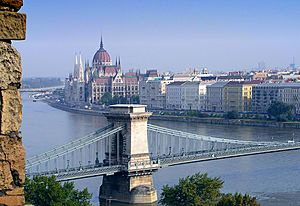

The Danube is a very important route for transportation. Since the Rhine-Main-Danube Canal was finished in 1992, the Danube is now part of a huge waterway that connects the North Sea (at Rotterdam) to the Black Sea (at Sulina). This route is about 3,500 kilometers (2,175 miles) long!
In 1994, the Danube was named one of the ten most important transport routes in Central and Eastern Europe. Before 1999, about 100 million tons of goods were transported on the Danube each year. However, in 1999, some bridges in Serbia were bombed during a conflict, which made it hard for ships to pass. The river was cleared by 2002, and a temporary bridge that blocked navigation was removed in 2005.
At the Iron Gate, the Danube flows through a deep gorge between Serbia and Romania. There are two large dams and power stations here, called Iron Gate I Hydroelectric Power Station and Iron Gate II Hydroelectric Power Station.
The Danube Delta
The Danube Delta is the largest river delta in the European Union. Most of it is in Romania, but a northern part is in Ukraine. It covers an area of about 4,152 square kilometers (1,603 square miles). If you include the nearby lagoons, the total area is even larger, about 5,165 square kilometers (1,994 square miles).
The Danube Delta is also the best-preserved river delta in Europe. It's so special that it's a UNESCO World Heritage Site and a Ramsar Site, which means it's recognized internationally for its important wetlands. Its lakes and marshes are home to 45 different kinds of freshwater fish. The wetlands also support huge groups of migratory birds, with over 300 different species, including the endangered pygmy cormorant.
Working Together for the Danube
Protecting the Environment
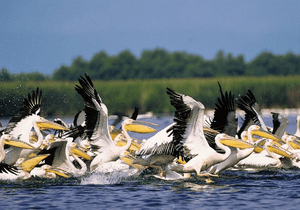
The International Commission for the Protection of the Danube River (ICPDR) is an organization that helps protect the Danube. It includes 14 countries that share the river basin, plus the European Union. Formed in 1998, their main goal is to keep the Danube clean and healthy. They work to manage the water wisely, protect nature, and make sure the river's resources are used fairly by everyone.
The Danube Commission focuses on keeping the river good for ships and boats. It was started in 1948 by seven countries along the river. Today, it includes representatives from Austria, Bulgaria, Croatia, Germany, Hungary, Moldova, Slovakia, Romania, Russia, Ukraine, and Serbia. They meet regularly to discuss how to keep the Danube open and safe for navigation. This commission continues a long history of international cooperation on the Danube, which started back in 1856.
The Danube's Long History
The area around the Danube has been home to some of the earliest human cultures. Ancient cultures like the Linear Pottery culture and the Vinča culture lived along the river thousands of years ago. The Vučedol culture (around 3000 BC) was known for its pottery.
Many important historical events happened along the Danube:
- In the 6th century BC, Darius the Great, the king of Persia, crossed the Danube to invade a region called Scythia.
- In 336 BC, Alexander the Great traveled as far as the Danube during his campaigns.
- Under the Roman Empire, the Danube was an important border and a route for moving soldiers and supplies. The Romans even built a famous bridge across the Danube in 101 CE, near Drobeta. This helped them conquer a region called Dacia.
- For centuries, the Ottoman Empire fought with the Kingdom of Hungary and later the Austrian Habsburgs for control of the Danube. Many battles were fought along the river, including the Battle of Vienna in 1683.
Fun Facts and Tourism
Drinking Water
The Danube provides drinking water for about 20 million people along its path. In some parts of Germany, a lot of the drinking water comes from the Danube after it's been cleaned. However, in places like Austria and Hungary, most drinking water comes from underground sources or springs, because the Danube can be quite polluted. Only in parts of Romania, where the water is cleaner, is the Danube regularly used for drinking water.
Fishing on the River
Fishing used to be very important on the Danube, especially in the Middle Ages. Today, it's not as big, but some fishermen still work on the river, and the Danube Delta still has an important fishing industry. The Danube is home to many fish species, including several types of sturgeon, which are now endangered.
Tourism and Activities
The Danube is a popular place for tourists. Beautiful places like the Wachau Valley in Austria, the Danube Delta in Romania, and the Iron Gate gorge are big attractions. Many people enjoy taking boat cruises on the river, especially between Vienna and Budapest. Some cruises even go all the way from Germany to the Danube Delta!
The Danube region is great for outdoor activities. It has good paths for cycling and hiking. In Austria alone, millions of people visit the Danube region each year. The Danube Banks in Budapest are so special that they are a UNESCO World Heritage Site.
Danube Bike Trail
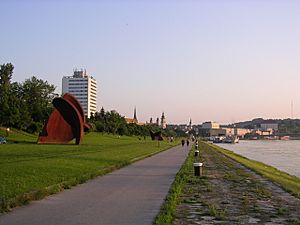
The Danube Bike Trail is a very popular bicycle path that follows the river from its start all the way to the Black Sea. The parts through Germany and Austria are especially famous. The trail is divided into four main sections:
- Donaueschingen to Passau (559 km or 347 miles)
- Passau to Vienna (340 km or 211 miles)
- Vienna to Budapest (306 km or 190 miles)
- Budapest to the Black Sea (1,670 km or 1,038 miles)
Sultans Trail
The Sultans Trail is a hiking path that runs along the Danube between Vienna and Smederevo in Serbia. From Smederevo, the trail leaves the Danube and continues to Istanbul.
Donausteig Hiking Trail
The Donausteig is another hiking trail that opened in 2010. It is 450 kilometers (280 miles) long and goes from Passau to Grein. It passes through many towns and offers amazing views of the Danube.
The Route of Emperors and Kings
This is a special tourist route that follows the Danube from Regensburg in Germany to Budapest. It passes through famous cities like Passau, Linz, and Vienna. This route is named after the many emperors and kings who traveled along the Danube in ancient Roman times and the Middle Ages. They used the river for travel and transport because it was easier than traveling by land. Many beautiful castles and palaces were built along the river by families like the Habsburg family. Today, you can still see these amazing buildings and visit UNESCO World Heritage cities like Regensburg, Wachau, and Vienna.
Important National Parks Along the Danube
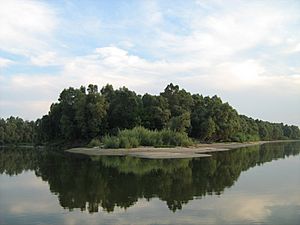
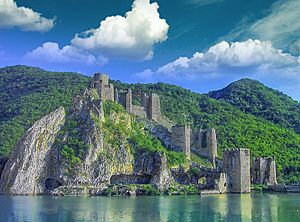
The Danube flows through or near many important natural areas and national parks that protect its unique environment. Some of these include:
- Naturpark Obere Donau (Germany)
- Nationalpark Donau Auen (Austria)
- Danube-Ipoly National Park (Hungary)
- Danube-Drava National Park (Hungary)
- Naturalpark Kopački Rit (Croatia)
- Gornje Podunavlje Nature Reserve (Serbia)
- Đerdap National park (Serbia)
- Iron Gates Natural Park (Romania)
- Persina Nature Park (Bulgaria)
- Srebarna Nature Reserve (Bulgaria)
- Danube Delta Biosphere Reserve (Romania)
- Danube Biosphere Reserve (Ukraine)
Cultural Importance

The Danube has inspired many artists and stories:
- The famous waltz On the Beautiful Blue Danube by Johann Strauss II is one of the most well-known pieces of classical music in the world. Another waltz, The Waves of the Danube, was written by Romanian composer Iosif Ivanovici.
- The Danube is mentioned in the Bulgarian National Anthem as a symbol of the country's beauty.
- The "Danube school" was a style of landscape painting that developed in the Danube valley in the 16th century.
- The book Danube by Claudio Magris is a famous essay where he travels the river and explores its rich history and cultures.
- Jules Verne's book The Danube Pilot tells the adventures of a fisherman traveling down the river.
- In the Star Trek universe, a type of starship called the Danube-class runabout is named after the river.
- In the Earth's Children book series by Jean M. Auel, the main characters travel along the Danube, which they call the "Great Mother River."
- A Hungarian sweet treat called Duna kavics ("Danube pebbles") is named after the river.
- The Danube Folk Ensemble is a Hungarian dance and music group named after the river.
Images for kids
-
The symbolic source of the Danube in Donaueschingen.
-
The Danube in Linz, Austria.
-
The Tisza River, the longest tributary of the Danube.
-
The Danube in Sulina, Romania.
-
The "0 km" marker in the Danube Delta in Ukraine, showing where the river meets the sea.
-
A satellite image from the European Space Agency showing where the Danube meets the Black Sea.
-
A 16th-century painting of the Danube landscape near Regensburg by Albrecht Altdorfer, an artist from the Danube school.
See also
 In Spanish: Danubio para niños
In Spanish: Danubio para niños



